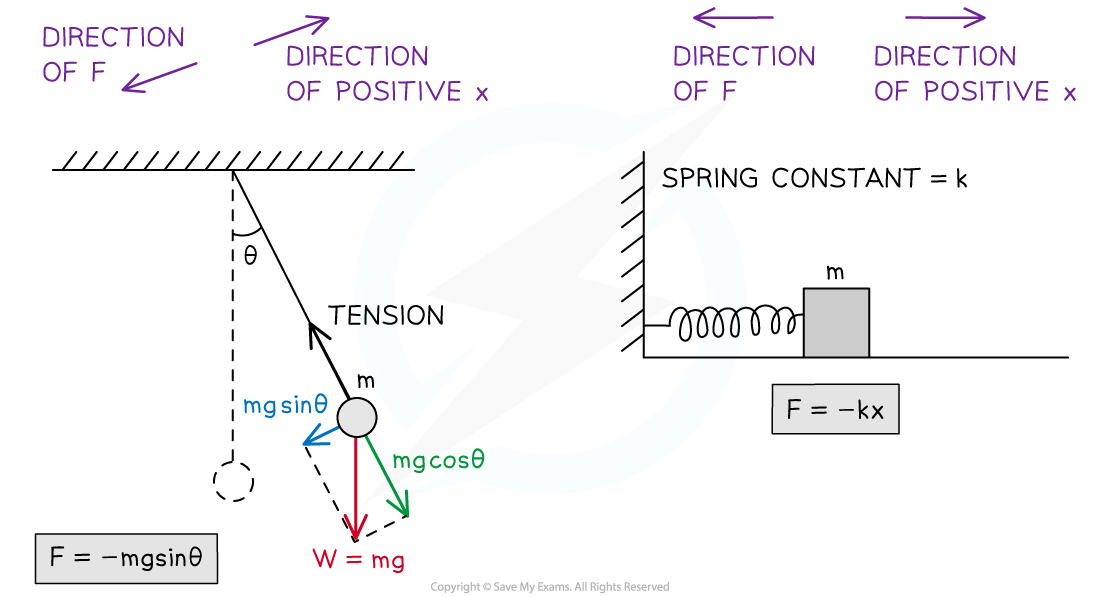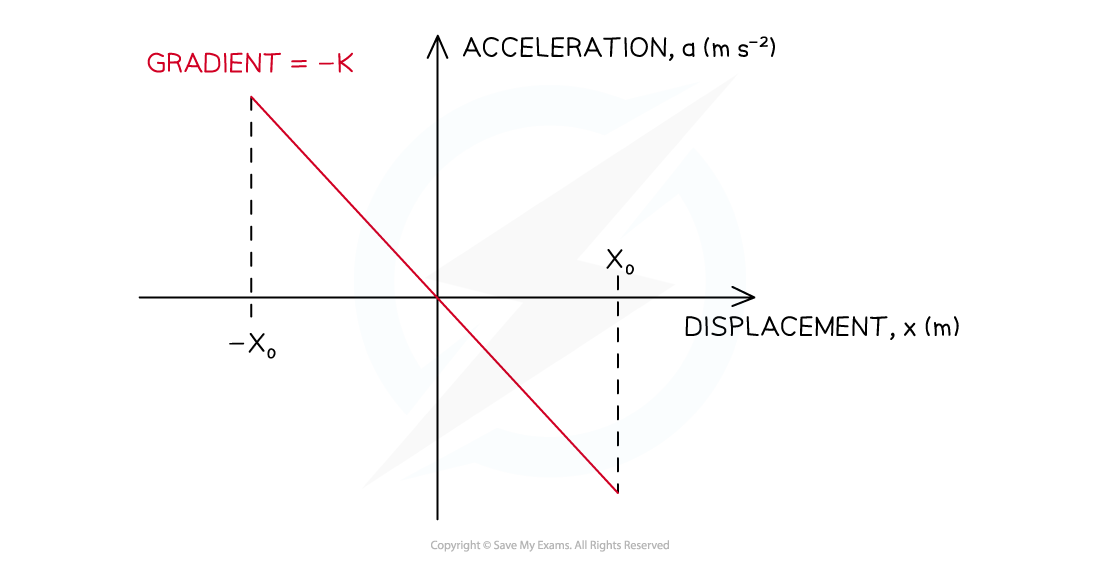Simple Harmonic Oscillations
- Simple harmonic motion (SHM) is defined as follows:
The motion of an object whose acceleration is directly proportional but opposite in direction to the object's displacement from a central equilibrium position
- An object is said to perform simple harmonic oscillations when all of the following apply:
- The oscillations are isochronous
- There is a central equilibrium point
- The object's displacement, velocity and acceleration change continuously
- There is a restoring force always directed towards the equilibrium point
- The magnitude of the restoring force is proportional to the displacement
Conditions for SHM
- The defining conditions of simple harmonic oscillations are that the restoring force and the acceleration must always be:
- Directed towards the equilibrium position, and hence, is always in the opposite direction to the displacement
- Directly proportional to the displacement
a ∝ −x
- Where:
- a = acceleration (m s−2)
- x = displacement (m)
The Restoring Force
- One of the defining conditions of simple harmonic motion is the existence of a restoring force
- Examples of restoring forces are:
- The component of the weight of a pendulum's bob that is parallel and opposite to the displacement of the bob
- The force of a spring, whose magnitude is given by Hooke's law

For a pendulum, the restoring force is provided by the component of the bob's weight that is perpendicular to the tension in the pendulum's string. For a mass-spring system, the restoring force is provided by the force of the spring.
- For a mass-spring system in simple harmonic motion, the relationship between the restoring force and the displacement of the object can be written as follows:
F = – kx
- Where:
- F = restoring force (N)
- k = spring constant (N m–1)
- x = displacement from the equilibrium position (m)

Graph of force against displacement for an object oscillating with SHM
- Force and displacement in SHM have a linear relationship where the gradient of the graph represents the constant
- In this case, the spring constant k
- An object in SHM will also have a restoring force to return it to its equilibrium position
- This restoring force will be directly proportional, but in the opposite direction, to the displacement of the object from its equilibrium position
Acceleration & Displacement
- According to Newton's Second Law, the net force on an object is directly proportional to the object's acceleration, F ∝ a for a constant mass
F = ma
- Where
- F = force (N)
- m = mass (kg)
- a = acceleration (m s−2)
- Since F = ma (Newton's second law), and F = −kx (Hooke's law), the equations can be set as equal to one another:
ma = – kx
- Rearranging to show the relationship between acceleration and displacement gives:
a = −x
- This equation shows that
- There is a linear relationship between the acceleration of the object moving with simple harmonic motion and its displacement from its equilibrium position
- The minus sign shows that when the mass on the spring is displaced to the right
- The direction of the acceleration is to the left and vice versa
- In other words, a and x are always in opposite directions to each other
- This equation shows acceleration is directly proportional but in the opposite direction to displacement for an object in SHM
a ∝ −x
- Therefore, it can be stated that:
a = −kx
- Where
- a = acceleration
- k = is a constant but in this instance not the spring constant
- x = displacement
- Note that in physics, k is the standard letter used for an undefined constant

Graph of acceleration against displacement for an object oscillating with SHM
Worked Example
A pendulum's bob oscillates about a central equilibrium position. The amplitude of the oscillations is 4.0 cm. The maximum value of the bob's acceleration is 2.0 m s–2.
Determine the magnitude of the bob's acceleration when the displacement from the equilibrium position is equal to 1.0 cm.
You may ignore energy losses.
Step 1: List the known quantities
-
- Amplitude of the oscillations, x0 = 4.0 cm = 0.04 m
- Maximum acceleration, a = 2.0 m s–2
- Displacement, x = 1.0 cm = 0.01 m
Remember to convert the amplitude of the oscillations and the displacement from centimetres (cm) into metres (m)
Step 2: Recall the relationship between the maximum acceleration a and the displacement x
-
- The maximum acceleration a occurs at the position of maximum displacement x = x0
a = – kx0
Step 3: Rearrange the above equation to calculate the constant of proportionality k
![]()
Step 4: Substitute the numbers into the above equation
![]()
k = – 50 s–2
Step 5: Use this value of k to calculate the acceleration a' when the displacement is x = 0.01 m
a' = – kx
a' = – (– 50) s–2 × 0.01 m
a' = 0.50 m s–2
